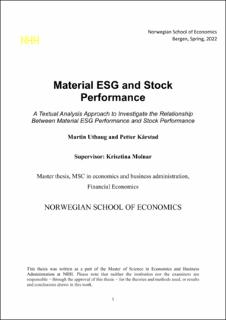Material ESG and Stock Performance: A Textual Analysis Approach to Investigate the Relationship Between Material ESG Performance and Stock Performance
Master thesis
Permanent lenke
https://hdl.handle.net/11250/3014279Utgivelsesdato
2022Metadata
Vis full innførselSamlinger
- Master Thesis [4372]
Sammendrag
This thesis investigates the relationship between material environmental, social and governance (ESG) performance and stock performance. We construct a new ESG score based on textual analysis of annual reports of companies listed on the Oslo Stock Exchange. The ESG score is a product of the presence of material ESG-related terms in the company's annual report. We use a custom ESG dictionary to identify material ESG-related words. Furthermore, we construct equal and value-weighted zero-investment portfolios, best-in-class portfolios, and negative screening portfolios to investigate if portfolios consisting of high ESG-scoring firms achieve abnormal stock returns. The ESG portfolio's excess returns are estimated using the Fama-French five-factor model + momentum.
We find that the equal-weighted zero-investment portfolio consisting of a long position in the top quintile ESG-scoring firms and a short position in the bottom quintile ESG-scoring firms achieve significant negative abnormal returns in the period 2008-2014. Furthermore, we find that an equal-weighted best-in-class portfolio that is consisting of the top quintile ESG-scoring companies, is also associated with negative abnormal returns in the same period. We do not find significant abnormal returns after 2014. We argue that the market has mispriced the risk associated with ESG companies in 2008-2014, and that a learning effect has led to ESG companies being correctly priced in recent years. We argue that the learning effect is due to an increased supply of material ESG metrics among investors.
